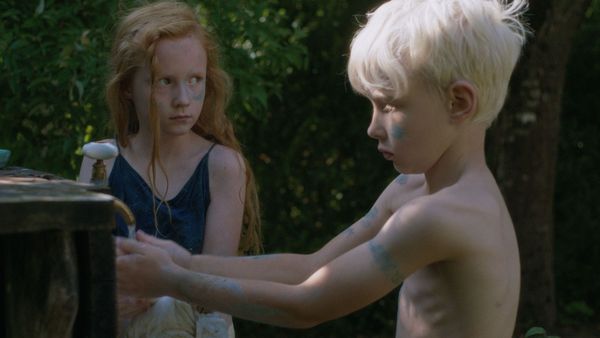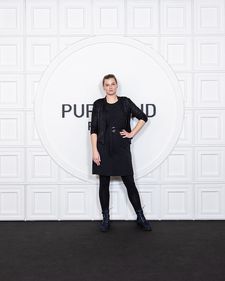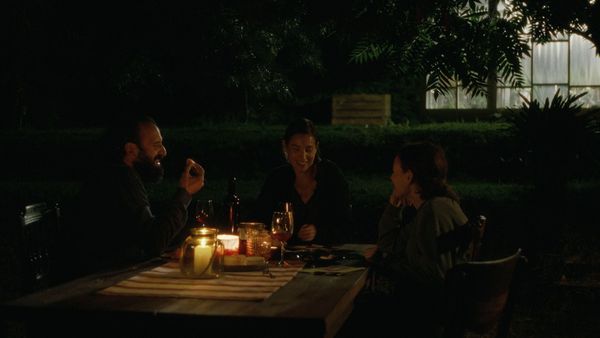 |
| Karolina (Inesa Sionova) and Rytis (Ajus Antanavicius) in Remember To Blink. Austėja Urbaitė: 'I see grown-ups in kids and I see kids in grown-ups. And I look for them behind the actions' |
But soon the burgeoning sisterly relationship between Gabi and Rytis (Ajus Antanavicius) and his slightly older sister Karolina (Inesa Sionova) leads to an unspoken rivalry between Gabi and Jacqueline that becomes increasingly serious.
 |
| Austėja Urbaitė in Tallinn. Urbaitė: 'When you have something driving you from inside, you just do it' Photo: Courtesy of POFF/Erlend Štaub |
The film, which is playing in the Baltic Film Competition at Tallinn after its world premiere in Warsaw, is partly inspired by Urbaitė's own encounters with children from time spent working with her mum’s event organisers from the age of 11.
“It was kids’ parties. I would play characters like Mary Poppins and playing with the kids so I’ve been developing relationships with kids since a very young age.Then I encountered a family that had adopted kids and I saw a completely different world.The first thing that struck me was how they are something else, very grown up in situations where you would want them to be kids, the things that they talk about, and you don't know how to react, and it's painful. And they're so smart. At some moments, you feel like they're more mature than you are. And then that same 11-year-old girl sometimes behaves like a four-year-old and is under-developed, like completely different parts of them have developed differently than in a secure family.
Then I started volunteering at the orphanage for two years. So I learned a lot of inspiration there.”
The idea of children acting like adults - and vice versa - is crucial to a film, where the women’s reaction to one another’s actions is often no better than you might expect in a schoolyard.
“I think we are like that,” says Urbaitė. “I see grown-ups in kids and I see kids in grown-ups. And I look for them behind the actions.”
The casting was a long process and involved the young actors improvising and playing. Urbaitė says: “I was not just putting them in front of the camera to play texts. Maybe we did one scene always from the script to see how their memory works. And howI could work with them.”
When it came to actually shooting the film, she adds: “I never give them a script. I had a way of preparation. First, we would meet each week and I would tell them just their story, what was happening to their characters and what they would think. Inesa would write things down in her own words. And Ajus was drawing. My most memorable recollection is after doing some work, I opened the notebook and there's some drawing and I don't really understand it. And I asked him what is this? And he says, “It's fishscale with saliva”. And that is a line that he has to say, in a drawing.
“He's a very smart boy, with a great memory and attention to detail. So they wrote their own scripts. They knew how their relationship developed and what changes over time, and this helped me then because we had to shoot out of order. There was no difference - it's just that they wrote their own scripts. They didn't know anything else, except for what happens to them. So we first started with that.
 |
| Austėja Urbaitė: 'I feel like the movie, in, out and all over, is about perspective' Photo: Courtesy of POFF |
Urbaitė explains: “I wanted nature to be part of the emotions. Also because of this comparison between nature that's very big and strong, powerful, and them so small, but everything inside them feeling so big. Then the insects that are even smaller, and they can shiver with the same power sometimes - it’s just the perspective. Yeah, I feel like the movie, in, out and all over, is about perspective.”
It’s a perspective that shifts over time for an audience watching the film as sympathies are pulled this way and that, largely because each woman is being viewed through the lens of the other. It’s ambiguous to the point that each viewer could end up picking different sides in terms of who to root for and, potentially, swap those over the course of the film.
“That was my main goal,” says Urbaitė, “And I feel mostly proud I've reached that, because I had a long journey where they were trying to push me to have one main character, and nobody could understand why I'm going down this road where everybody will pick someone else, or they won't be able to pick or they will change their minds. But for me, that you have this journey, is the idea of a movie. That's why I did it.”
The pastoral and remote setting was also key for the director. “I always wanted them to be separated from the exterior world and the perspective of others,” she says. “This way, you can be completely concentrated or yourself and go into your own fears and pain without stepping back from them and without anybody impacting you or opening your eyes a little bit. You're completely focused on yourself in this way because there's nothing else to impact you. So that was always there.”
When it comes to nature in the film, snakes play a key role, not just the animals themselves, but also in an artwork that Leon is making. When I ask Urbaitė how she feels about them, she says: “I fear and respect them.”
On their use as a motif, she adds: “I don't remember particularly where it started off. But there is a sense of a garden turning into hell, because a woman is going downhill because of her jealousy, envy or whatever. So it started maybe from there. I think the Gorgon came when I was thinking about Jacqueline's past, because Medusa was turned into this monster after she was raped - it's a story of pain. So I think that inspiration comes from from the relation to Jacqueline’s pain also that it's hidden.
“For me, it's very much about the duality of the symbol. Because you have, in a Catholic way, you have the snake as something evil and the Gorgon, also, as a monster as Gabi is portraying her to the kids. But Leon, on the other hand, is portraying her with the nature and the bird, more like a Goddess than a monster. So that's another perspective. In paganism, the snake actually means the sort of the mother of earth, so it's not one or the other.
“In the beginning, you have the, cliche symbolism going into your head, its dange. But do you really hate the Gorgon by the end or do you start to understand her and find the beauty?
Looking ahead to future projects, Urbaitė says she’s applying for a writing scholarship for a new project that’s currently in its research stages. With her films she says she always wants to “really dive into the topic” and anticipates it might take a few years to make.
She adds: “I think I'm sticking to a sort of psychology. I'm interested a lot in the relativity of memory and the way you can perceive what you see around you. I wrote a synopsis for a woman now just because of some more physical actions happening in the film, and I thought I could just as easily make it about a man. So it's an option I'm keeping in my head. I think diving deep because if you want to dive in very deep under the skin of someone as I want to do through the eyes, it is easier to go through a woman's role also not because of my own experiences, but because I talk to females so much. They come to you with their stories advice and fears and confusions. So you have such a wide spectrum.
“Maybe it will be an interesting challenge. I have a friend who said, ‘You always pick the hard way,” It’s not to be difficult, I get bored if I don’t feel I’m learning. I need to constantly feel that I'm learning and moving. I think that's normal for everyone in life. That's how to feel that you are living.”
Read our interview with Anne Azoulay and Dovile Kundrotaite on the challenges of working with children in Remember To Blink.





















